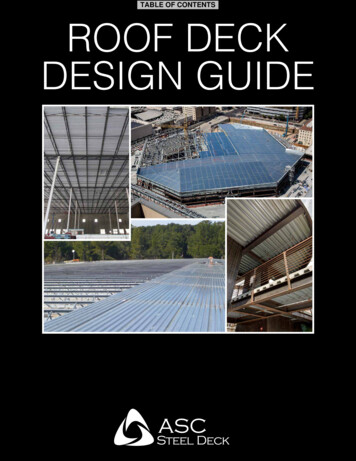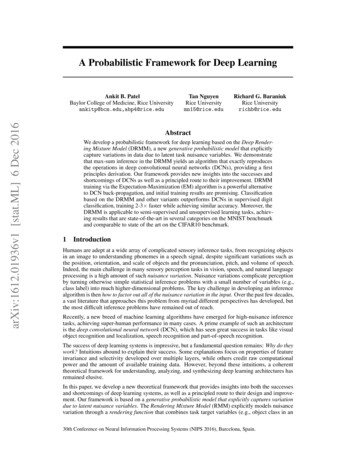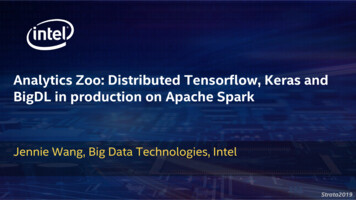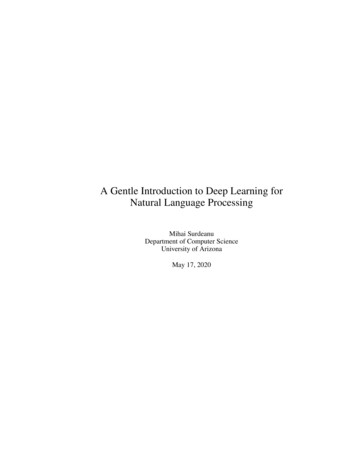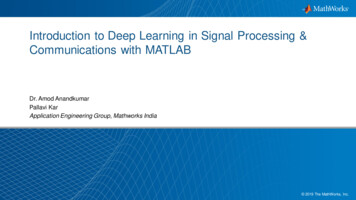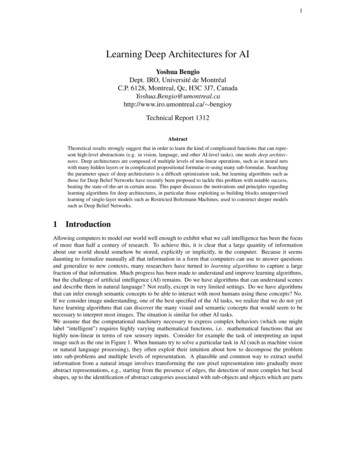
Transcription
1Learning Deep Architectures for AIYoshua BengioDept. IRO, Université de MontréalC.P. 6128, Montreal, Qc, H3C 3J7, ntreal.ca/ bengioyTechnical Report 1312AbstractTheoretical results strongly suggest that in order to learn the kind of complicated functions that can represent high-level abstractions (e.g. in vision, language, and other AI-level tasks), one needs deep architectures. Deep architectures are composed of multiple levels of non-linear operations, such as in neural netswith many hidden layers or in complicated propositional formulae re-using many sub-formulae. Searchingthe parameter space of deep architectures is a difficult optimization task, but learning algorithms such asthose for Deep Belief Networks have recently been proposed to tackle this problem with notable success,beating the state-of-the-art in certain areas. This paper discusses the motivations and principles regardinglearning algorithms for deep architectures, in particular those exploiting as building blocks unsupervisedlearning of single-layer models such as Restricted Boltzmann Machines, used to construct deeper modelssuch as Deep Belief Networks.1IntroductionAllowing computers to model our world well enough to exhibit what we call intelligence has been the focusof more than half a century of research. To achieve this, it is clear that a large quantity of informationabout our world should somehow be stored, explicitly or implicitly, in the computer. Because it seemsdaunting to formalize manually all that information in a form that computers can use to answer questionsand generalize to new contexts, many researchers have turned to learning algorithms to capture a largefraction of that information. Much progress has been made to understand and improve learning algorithms,but the challenge of artificial intelligence (AI) remains. Do we have algorithms that can understand scenesand describe them in natural language? Not really, except in very limited settings. Do we have algorithmsthat can infer enough semantic concepts to be able to interact with most humans using these concepts? No.If we consider image understanding, one of the best specified of the AI tasks, we realize that we do not yethave learning algorithms that can discover the many visual and semantic concepts that would seem to benecessary to interpret most images. The situation is similar for other AI tasks.We assume that the computational machinery necessary to express complex behaviors (which one mightlabel “intelligent”) requires highly varying mathematical functions, i.e. mathematical functions that arehighly non-linear in terms of raw sensory inputs. Consider for example the task of interpreting an inputimage such as the one in Figure 1. When humans try to solve a particular task in AI (such as machine visionor natural language processing), they often exploit their intuition about how to decompose the probleminto sub-problems and multiple levels of representation. A plausible and common way to extract usefulinformation from a natural image involves transforming the raw pixel representation into gradually moreabstract representations, e.g., starting from the presence of edges, the detection of more complex but localshapes, up to the identification of abstract categories associated with sub-objects and objects which are parts
of the image, and putting all these together to capture enough understanding of the scene to answer questionsabout it. We view the raw input to the learning system as a high dimensional entity, made of many observedvariables, which are related by unknown intricate statistical relationships. For example, using knowledgeof the 3D geometry of solid object and lighting, we can relate small variations in underlying physical andgeometric factors (such as position, orientation, lighting of an object) with changes in pixel intensities forall the pixels in an image. In this case, our knowledge of the physical factors involved allows one to get apicture of the mathematical form of these dependencies, and of the shape of the set of images associatedwith the same 3D object. If a machine captured the factors that explain the statistical variations in the data,and how they interact to generate the kind of data we observe, we would be able to say that the machineunderstands those aspects of the world covered by these factors of variation. Unfortunately, in general andfor most factors of variation underlying natural images, we do not have an analytical understanding of thesefactors of variation. We do not have enough formalized prior knowledge about the world to explain theobserved variety of images, even for such an apparently simple abstraction as MAN, illustrated in Figure 1.A high-level abstraction such as MAN has the property that it corresponds to a very large set of possibleimages, which might be very different from each other from the point of view of simple Euclidean distancein the space of pixel intensities. The set of images for which that label could be appropriate forms a highlyconvoluted region in pixel space that is not even necessarily a connected region. The MAN category can beseen as a high-level abstraction with respect to the space of images. What we call abstraction here can be acategory (such as the MAN category) or a feature, a function of sensory data, which can be discrete (e.g., theinput sentence is at the past tense) or continuous (e.g., the input video shows an object moving at a particularvelocity). Many lower level and intermediate level concepts (which we also call abstractions here) would beuseful to construct a MAN-detector. Lower level abstractions are more directly tied to particular percepts,whereas higher level ones are what we call “more abstract” because their connection to actual percepts ismore remote, and through other, intermediate level abstractions.We do not know exactly how to build robust MAN detectors or even intermediate abstractions that wouldbe appropriate. Furthermore, the number of visual and semantic categories (such as MAN) that we wouldlike an “intelligent” machine to capture is large. The focus of deep architecture learning is to automaticallydiscover such abstractions, from the lowest level features to the highest level concepts. Ideally, we would likelearning algorithms that enable this discovery with as little human effort as possible, i.e., without having tomanually define all necessary abstractions or having to provide a huge set of relevant hand-labeled examples.If these algorithms could tap into the huge resource of text and images on the web, it would certainly help totransfer much of human knowledge into machine-interpretable form.One of the important points we argue in the first part of this paper is that the functions learned should have astructure composed of multiple levels, analogous to the multiple levels of abstraction that humans naturallyenvision when they describe an aspect of their world. The arguments rest both on intuition and on theoreticalresults about the representational limitations of functions defined with an insufficient number of levels. Sincemost current work in machine learning is based on shallow architectures, these results suggest investigatinglearning algorithms for deep architectures, which is the subject of the second part of this paper.In much of machine vision systems, learning algorithms have been limited to specific parts of such a processing chain. The rest of of design remains labor-intensive, which might limit the scale of such systems.On the other hand, a hallmark of what we would consider intelligent includes a large enough vocabulary ofconcepts. Recognizing MAN is not enough. We need algorithms that can tackle a very large set of suchtasks and concepts. It seems daunting to manually define that many tasks, and learning becomes essentialin this context. It would seem foolish not to exploit the underlying commonalities between these these tasksand between the concepts they require. This has been the focus of research on multi-task learning (Caruana,1993; Baxter, 1995; Intrator & Edelman, 1996; Baxter, 1997). Architectures with multiple levels naturally provide such sharing and re-use of components: the low-level visual features (like edge detectors) andintermediate-level visual features (like object parts) that are useful to detect MAN are also useful for a largegroup of other visual tasks. In addition, learning about a large set of interrelated concepts might provide akey to the kind of broad generalizations that humans appear able to do, which we would not expect from2
separately trained object detectors, with one detector per visual category. If each high-level category is itselfrepresented through a particular configuration of abstract features, generalization to unseen categories couldfollow naturally from new configurations of these features. Even though only some configurations of thesefeatures would be present in the training examples, if they represent different aspects of the data, new examples could meaningfully be represented by new configurations of these features. This idea underlies theconcept of distributed representation that is at the core of many of the learning algorithms described in thispaper, and discussed in Section 4.Figure 1: We would like the raw input image to be transformed into gradually higher levels of representation,representing more and more abstract functions of the raw input, e.g., edges, local shapes, object parts, etc.In practice, we do not know in advance what the “right” representation should be for all these levels ofabstractions, although linguistic concepts might help us imagine what the higher levels might implicitlyrepresent.This paper has two main parts which can be read almost independently. In the first part, Sections 2, 3and 4 use mathematical arguments to motivate deep architectures, in which each level is associated with adistributed representation of the input. The second part (in the remaining sections) covers current learningalgorithms for deep architectures, with a focus on Deep Belief Networks, and their component layer, theRestricted Boltzmann Machine.The next two sections of this paper review mathematical results that suggest limitations of many existinglearning algorithms. Two aspects of these limitations are considered: insufficient depth of architectures, andlocality of estimators. To understand the notion of depth of architecture, one must introduce the notionof a set of computational elements. An example of such a set is the set of computations performed by an3
artificial neuron. A function can be expressed by the composition of elements from this set, using a graphwhich formalizes this composition, with one node per computational element. Depth of architecture refersto the depth of that graph, i.e. the longest path from an input node to an output node. When the set ofcomputational elements is the set of computations an artificial neuron can make (depending on its parameter values), depth corresponds to the number of layers in a neural network. Section 2 reviews theoreticalresults showing that an architecture with insufficient depth can require many more computational elements,potentially exponentially more (with respect to input size), than architectures whose depth is matched to thetask. This is detrimental for learning. Indeed, if a function represents a solution to the task with a very largebut shallow architecture (with many computational elements), a lot of training examples might be neededto tune each of these elements. We say that the expression of a function is compact when it has few computational elements, i.e. less degrees of freedom that can be tuned by learning. So for a fixed number oftraining examples, we would expect that compact representations of the target function would yield bettergeneralization.Connected to the depth question is the question of locality of estimators, discussed in Section 3. This isanother, more geometrically obvious, limitation of a large class of non-parametric learning algorithms: theyobtain good generalization for a new input x by mostly exploiting training examples in the neighborhoodof x. For example, the k nearest neighbors of the test point x, among the training examples, vote for theprediction at x. This locality issue is directly connected to the literature on the curse of dimensionality, butthe results we cite show that what matters for generalization is not dimensionality, but instead the numberof “variations” of the function we wish to obtain after learning. For example, if the function representedby the model is piecewise-constant (e.g. decision trees), then the question that matters is the number ofpieces required to approximate properly the target function. There are connections between the number ofvariations and the input dimension: one can readily design families of target functions for which the numberof variations is exponential in the input dimension, such as the parity function with d inputs.Section 4 suggests how deep architectures could be exploited to extract multiple levels of distributed representations, where the set of configurations of values at each level of the computation graph can be verylarge. This would allow us to compactly represent a complicated function of the input.In the remainder, the paper describes and analyses some of the algorithms that have been proposed to traindeep architectures.1 Many of these algorithms are based on the autoassociator: a simple unsupervised algorithm for learning a one-layer model that computes a distributed representation for its input (Rumelhart,Hinton, & Williams, 1986a; Bourlard & Kamp, 1988; Hinton & Zemel, 1994). We also discuss convolutional neural networks, the oldest successful example of deep architecture, specialized for vision andsignal processing tasks (LeCun, Boser, Denker, Henderson, Howard, Hubbard, & Jackel, 1989; LeCun, Bottou, Bengio, & Haffner, 1998b). Sections 9 and 10 are devoted to a family of more recently proposed learningalgorithms that have been very successful to train deep architectures: Deep Belief Networks (DBNs) (Hinton, Osindero, & Teh, 2006) and Stacked Autoassociators (Bengio, Lamblin, Popovici, & Larochelle, 2007;Ranzato, Poultney, Chopra, & LeCun, 2007). DBNs are based on Restricted Boltzmann Machines (RBMs)and the Contrastive Divergence algorithm (Hinton, 2002), introduced in Section 6. In Section 7 we describeestimators of the log-likelihood gradient for RBMs. This analysis shows how reconstruction error (usedto train autoassociators), and Contrastive Divergence (used to train RBMs) approximate the log-likelihoodgradient. Section 8 generalizes as much as possible the parametrization of RBMs so as to keep its basicfactorizing property and the Contrastive Divergence estimator of the gradient. Finally, we consider the mostchallenging question: how can we possibly deal with the difficult optimization problem that training thesedeep architectures entails? This part of the paper contains mostly questions and suggestions for researchdirections. In particular, we discuss the principle of continuation methods, which first solves smoother versions of the desired cost function, to make a dent in the optimization of deep architectures, and we find thatexisting algorithms for RBMs and DBNs already are approximate continuation methods.1 Mostly deep neural networks, to date, but we suggest later that ensembles of trees could be learned and stacked similarly to layersin a neural network.4
1.1Desiderata for Learning AISummarizing some of the above issues, we state a number of requirements we perceive for learning algorithms to solve AI. Ability to learn complex, highly-varying functions, i.e., with a number of variations much greater thanthe number of training examples. Ability to learn with little human input the low-level, intermediate, and high-level abstractions thatwould be useful to represent the kind of complex functions needed for AI tasks. Ability to learn from a very large set of examples: computation time for training should scale wellwith the number of examples, i.e. close to linearly. Ability to learn from mostly unlabeled data, i.e. to work in the semi-supervised setting, where not allthe examples come with the “right” associated labels. Ability to exploit the synergies present across a large number of tasks, i.e. multi-task learning. Thesesynergies exist because all the AI tasks provide different views on the same underlying reality. In the limit of a large number of tasks and when future tasks are not known ahead of time, strongunsupervised learning (i.e. capturing the statistical structure in the observed data) is an importantelement of the solution.Other elements are equally important but are not directly connected to the material in this paper. Theyinclude the ability to learn to represent context of varying length and structure (Pollack, 1990), so as toallow machines to operate in a stream of observations and produce a stream of actions, the ability to makedecisions when actions influence the future observations and future rewards (Sutton & Barto, 1998), and theability to influence future observations so as to collect more relevant information about the world (i.e. a formof active learning (Cohn, Ghahramani, & Jordan, 1995)).2Theoretical Limitations of Shallow ArchitecturesIn this section, we present an argument in favor of deep architecture models by way of theoretical results revealing limitations of archictectures with insufficient depth. This part of the paper (this section and the next)motivate the algorithms described in the later sections, and can be skipped without making the remainderdifficult to follow. The main conclusion of this section is that functions that can be compactly representedby a depth k architecture might require an exponential number of computational elements to be representedby a depth k 1 architecture. Since the number of computational elements one can afford depends on thenumber of training examples available to tune or select them, the consequences are not just computationalbut also statistical: poor generalization may be expected when using an insufficiently deep architecture forrepresenting some functions.We consider the case of fixed-dimension inputs, where the computation performed by the machine can berepresented by a directed acyclic graph where each node performs a computation that is the application ofa function on its inputs, each of which is the output of another node in the graph or one of the externalinputs to the graph. The whole graph can be viewed as a circuit that computes a function applied to theexternal inputs. When the set of functions allowed for the computation nodes is limited to logic gates, suchas { AND, OR, NOT }, this is a boolean circuit, or logic circuit.Let us return to the notion of depth with more examples of architectures of different depths. Consider thefunction f (x) x sin(a x b). It can be expressed as the composition of simple operations such asaddition, subtraction, multiplication, and the sin operation, as illustrated in Figure 2. In the example, therewould be a different node for the multiplication a x and for the final multiplication by x. Each node inthe graph is associated with an output value obtained by applying some function on input values that are5
outputoutput*elementsetelementsetsinneuron* neuronneuronneuronsin neuron.*neuron neuron neuronneuron xabinputsinputsFigure 2: Examples of functions represented by a graph of computations, where each node is taken insome set of allowed computations. Left: the elements are { , , sin} . The architecture computesx sin(a x b) and has depth 4. Right: the elements are artificial neurons computing f (x) tanh(b w0 x);each element in the set has a different (w, b) parameter. The architecture is a multi-layer neural network ofdepth 3.the outputs of other nodes of the graph. For example, in a logic circuit each node can compute a booleanfunction taken from a small set of boolean functions. The graph as a whole has input nodes and output nodesand computes a function from input to output. The depth of an architecture is the maximum length of a pathfrom any input of the graph to any output of the graph, i.e. 3 in the case of x sin(a x b) in Figure 2. If we include affine operations and sigmoids in the set of computational elements, linear regressionand logistic regression have depth 1, i.e., have a single level. When we put a fixed kernel computation K(u, v) in the set of allowed operations, along with affineoperations, kernel machines (Schölkopf, Burges, & Smola, 1999a) with a fixed kernel can be considered to have two levels. The first level has one element computing K(x, xi ) for each prototype xi (aselected representative training example) andPmatches the input vector x with the prototypes xi . Thesecond level performs a linear combination i αi K(x, xi ) to associate the matching prototypes xiwith the expected response. When we put artificial neurons (affine transformation followed by a non-linearity) in our set of elements, we obtain ordinary multi-layer neural networks (Rumelhart et al., 1986a). With the mostcommon choice of one hidden layer, they also have depth two (the hidden layer and the output layer). Decision trees can also be seen as having two levels, as discussed in Section 3.3. Boosting (Freund & Schapire, 1996) usually adds one level to its base learners: that level computes avote or linear combination of the outputs of the base learners. Stacking (Wolpert, 1992) is another meta-learning algorithm that adds one level. Based on current knowledge of brain anatomy (Serre, Kreiman, Kouh, Cadieu, Knoblich, & Poggio,2007), it appears that the cortex can be seen as a deep architecture, e.g., consider the many so-calledlayers in the visual system.Although depth depends on the choice of the set of allowed computations for each element, theoreticalresults suggest that it is not the absolute number of levels that matters, but the number of levels relative tohow many are required to represent efficiently the target function (with some choice of set of computationalelements). As we will describe, if a function can be compactly represented with k levels using a particular6
choice of computational element set, it might require a huge number of computational elements to representit with k 1 or less levels (using that same computational element set).The most formal arguments about the power of deep architectures come from investigations into computational complexity of circuits. The basic conclusion that these results suggest is that when a function can becompactly represented by a deep architecture, it might need a very large architecture to be represented byan insufficiently deep one.A two-layer circuit of logic gates can represent any boolean function (Mendelson, 1997). Any booleanfunction can be written as a sum of products (disjunctive normal form: AND gates on the first layer withoptional negation of inputs, and OR gate on the second layer) or a product of sums (conjunctive normalform: OR gates on the first layer with optional negation of inputs, and AND gate on the second layer). Tounderstand the limitations of shallow architectures, the first important result to consider is that with depthtwo logical circuits, most boolean functions require an exponential number of logic gates (Wegener, 1987)to be represented (with respect to input size).Furthermore, there are functions computable with a polynomial-size logic gates circuit of depth k that requireexponential size when restricted to depth k 1 (Hastad, 1986). The proof of this theorem relies on earlierresults (Yao, 1985) showing that d-bit parity circuits of depth 2 have exponential size. The d-bit parityfunction is defined as usual: Pd1 ifdi 1 bi is evenparity : (b1 , . . . , bd ) {0, 1} 7 1 otherwise.One might wonder whether these computational complexity results for boolean circuits are relevant to machine learning. See Orponen (1994) for an early survey of theoretical results in computational complexityrelevant to learning algorithms. Interestingly, many of the results for boolean circuits can be generalizedto architectures whose computational elements are linear threshold units (also known as artificial neurons (McCulloch & Pitts, 1943)), which computef (x) w 0 x b 0(1)with parameters w and b. The fan-in of a circuit is the maximum number of inputs of a particular element.Circuits are often organized in layers, like multi-layer neural networks, where elements in a layer only taketheir input from elements in the previous layer(s), and the first layer is the neural network input. The size ofa circuit is the number of its computational elements (excluding input elements, which do not perform anycomputation).One might argue that the limitations of logic gates circuits might not apply to the kind of architecturesfound in machine learning algorithms. With that in mind, it is interesting to note that similar theorems wereproved for circuits of linear threshold units, which are the computational elements of some multi-layer neuralnetworks. Of particular interest is the following theorem, which applies to monotone weighted thresholdcircuits (i.e. multi-layer neural networks with linear threshold units and positive weights) when trying torepresent a function compactly representable with a depth k circuit:Theorem 2.1. A monotone weighted threshold circuit of depth k 1 computing a function fk Fk,N hassize at least 2cN for some constant c 0 and N N0 (Hastad & Goldmann, 1991).The class of functions Fk,N is defined as follows. It contains functions of N 2k 2 variables each defined bya depth k circuit that is a tree. At the leaves of the tree there are unnegated input variables, and the functionvalue is at the root. The i-th level from the bottom consists of AND gates when i is even and OR gates wheni is odd. The fan-in at the top and bottom level is N and at all other levels it is N 2 .The above results do not prove that other classes of functions (such as those we want to learn to performAI tasks) require deep architectures, nor that these demonstrated limitations apply to other types of circuits.However, these theoretical results beg the question: are the depth 1, 2 and 3 architectures (typically foundin most machine learning algorithms) too shallow to represent efficiently more complicated functions? Results such as the above theorem also suggest that there might be no universally right depth: each function7
(i.e. each task) might require a particular minimum depth (for a given set of computational elements). Weshould therefore strive to develop learning algorithms that use the data to determine the depth of the finalarchitecture.Depth of architecture is connected to the notion of highly-varying functions. We argue that, in general, deeparchitectures can compactly represent highly-varying functions which would otherwise require a very largesize to be represented with an inappropriate architecture. We say that a function is highly-varying whena piecewise approximation (e.g., piecewise-constant or piecewise-linear) of that function would require alarge number of pieces. A deep architecture is a composition of many operations, and it could in any casebe represented by a possibly very large depth-2 architecture. The composition of computational units in asmall but deep circuit can actually be seen as an efficient factorization of a large but shallow circuit. Reorganizing the way in which computational units are composeda drastic effect on the efficiency ofQn canPhavemrepresentation size. For example, whereas the polynomial i 1 j 1 aij xj can be represented efficientlyas a product of sums, with only O(mn) computational elements, it would be very inefficiently representedwith a sum of product architecture, requiring O(nm ) computational elements.Further examples suggesting greater expressive power of deep architectures and their potential for AI andmachine learning are also discussed in Bengio and Le Cun (2007). An earlier discussion of the expectedadvantages of deeper architectures in a more cognitive perspective is found in Utgoff and Stracuzzi (2002).Having established some theoretical grounds justifying the need for learning deep architectures, we next turnto a related question: deep architectures can represent highly-varying functions compactly, with less computational elements than there are variations in the represented function, but many state-of-the-art machinelearning algorithms do not have that characteristic.To conclude, a number of computational complexity results strongly suggest that functions that can be compactly represented with a depth k architecture could require a very large number of elements in order to berepresented by a shallower architecture. Since each element of the architecture might have to be selected,i.e., learned, using examples, these results mean that depth of architecture can be very important from thepoint of view a statistical efficiency.3Local vs Non-Local Generalization: the Limits of Matching LocalTemplatesThis section focuses on the locality of estimators in many shallow architectures, which gives rise to poorgeneralization when trying to learn highly-varying functions. This is because highly-varying functions,which can sometimes be represented efficiently with deep architectures, cannot be represented efficiently ifthe learning algorithm is a local estimator.A local estimator partitions the input space in regions (possibly in a soft rather than hard way) and requiresdifferent parameters or degrees of freedom to account for the possible shape of the target function in each ofthe regions. When many regions are necessary because the function is highly varying, the number of requiredparameters will also be large, and thus the number of ex
Aplausible and common way to extract useful . of the 3D geometry of solid object and lighting, we can relate small variations in underlying physical and . concept of distributed representation that is at the




